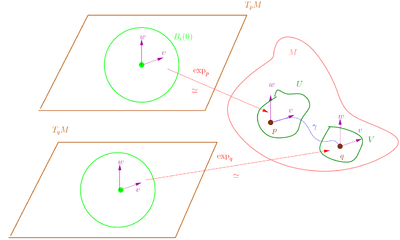Gauss's lemma (Riemannian geometry)
In Riemannian geometry, Gauss's lemma asserts that any sufficiently small sphere centered at a point in a Riemannian manifold is perpendicular to every geodesic through the point. More formally, let M be a Riemannian manifold, equipped with its Levi-Civita connection, and p a point of M. The exponential map is a mapping from the tangent space at p to M:
which is a diffeomorphism in a neighborhood of zero. Gauss' lemma asserts that the image of a sphere of sufficiently small radius in TpM under the exponential map is perpendicular to all geodesics originating at p. The lemma allows the exponential map to be understood as a radial isometry, and is of fundamental importance in the study of geodesic convexity and normal coordinates.
Introduction
We define the exponential map at by
where is the unique geodesic with and tangent and is chosen small enough so that for every the geodesic is defined in 1. So, if is complete, then, by the Hopf–Rinow theorem, is defined on the whole tangent space.
Let be a curve differentiable in such that and . Since , it is clear that we can choose . In this case, by the definition of the differential of the exponential in applied over , we obtain:
So (with the right identification ) the differential of is the identity. By the implicit function theorem, is a diffeomorphism on a neighborhood of . The Gauss Lemma now tells that is also a radial isometry.
The exponential map is a radial isometry
Let . In what follows, we make the identification .
Gauss's Lemma states: Let and . Then,
For , this lemma means that is a radial isometry in the following sense: let , i.e. such that is well defined. And let . Then the exponential remains an isometry in , and, more generally, all along the geodesic (in so far as is well defined)! Then, radially, in all the directions permitted by the domain of definition of , it remains an isometry.

Proof
Recall that
We proceed in three steps:
- : let us construct a curve
such that and . Since , we can put . We find that, thanks to the identification we have made, and since we are only taking equivalence classes of curves, it is possible to choose (these are exactly the same curves, but shifted because of the domain of definition ; however, the identification allows us to gather them around . Hence,
Now let us calculate the scalar product .
We separate into a component parallel to and a component normal to . In particular, we put , .
The preceding step implies directly:
We must therefore show that the second term is null, because, according to Gauss's Lemma, we must have:
- :

Let us define the curve
Note that
Let us put:
and we calculate:
and
Hence
We can now verify that this scalar product is actually independent of the variable , and therefore that, for example:
because, according to what has been given above:
being given that the differential is a linear map. This will therefore prove the lemma.
- We verify that : this is a direct calculation. Since the maps are geodesics,
Since the maps are geodesics, the function is constant. Thus,
See also
References
- do Carmo, Manfredo (1992), Riemannian geometry, Basel, Boston, Berlin: Birkhäuser, ISBN 978-0-8176-3490-2